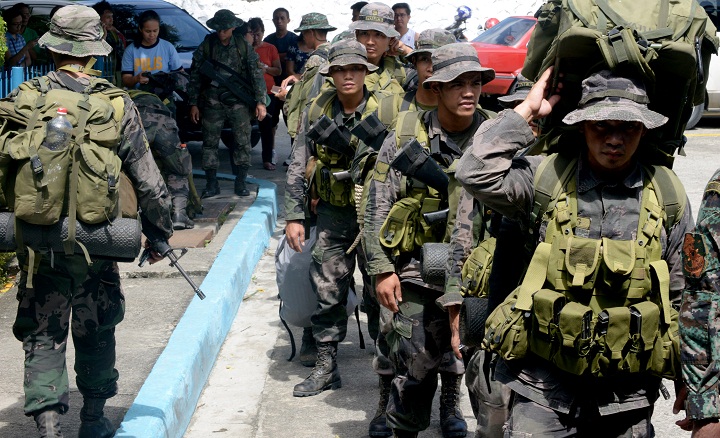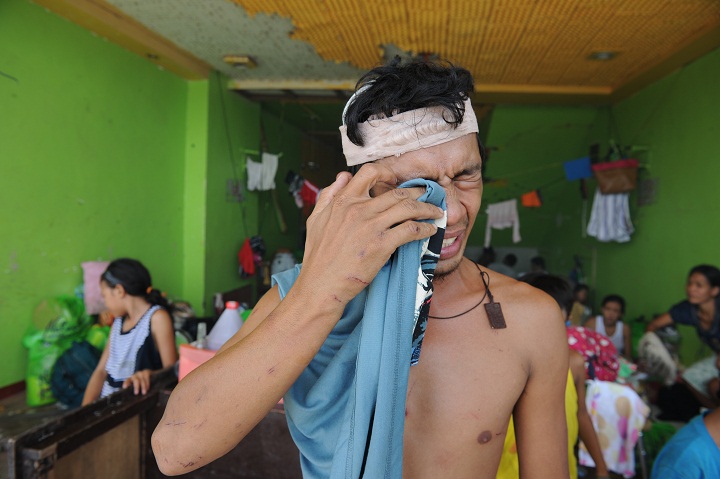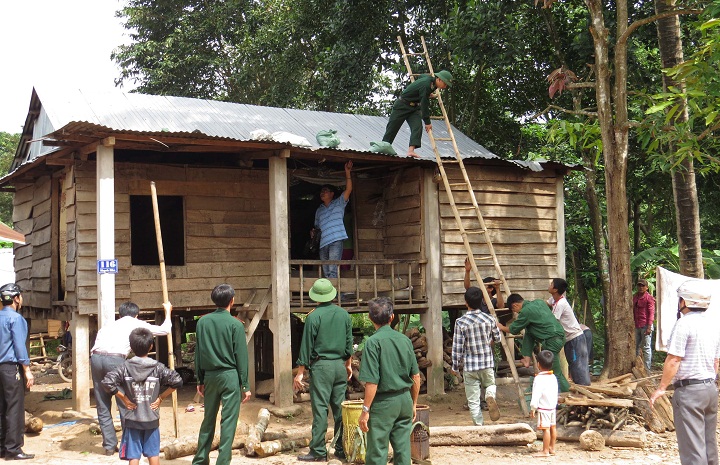Watch: Typhoon Haiyan made landfall in Vietnam early on Monday morning, three days after causing massive destruction in the Philippines.

- Canadians needing urgent consular help following Typhoon Haiyan can email sos@international.gc.ca or call collect 613-996-8885.
- Canadian Red Cross is accepting donations here: http://www.redcross.ca/typhoon
TACLOBAN, Philippines – As many as 10,000 people are believed dead in one Philippine city alone after one of the worst storms ever recorded unleashed ferocious winds and giant waves that washed away homes and schools. Corpses hung from tree branches and were scattered along sidewalks and among flattened buildings, while looters raided grocery stores and gas stations in search of food, fuel and water.
Officials projected the death toll could climb even higher when emergency crews reach areas cut off by flooding and landslides. Even in the disaster-prone Philippines, which regularly contends with earthquakes, volcanoes and tropical cyclones, Typhoon Haiyan appears to be the deadliest natural disaster on record.
Haiyan hit the eastern seaboard of the Philippine archipelago on Friday and quickly barrelled across its central islands before exiting into the South China Sea, packing winds of 235 kilometres per hour (147 miles per hour) that gusted to 275 kph (170 mph), and a storm surge that caused sea waters to rise 6 metres (20 feet).
Read more: Canada expresses sympathy to Typhoon Haiyan victims
- Trudeau tight-lipped on potential U.S. TikTok ban as key bill passes
- Canadian man dies during Texas Ironman event. His widow wants answers as to why
- Hundreds mourn 16-year-old Halifax homicide victim: ‘The youth are feeling it’
- On the ‘frontline’: Toronto-area residents hiring security firms to fight auto theft
It wasn’t until Sunday that the scale of the devastation became clear, with local officials on hardest-hit Leyte Island saying that there may be 10,000 dead in the provincial capital of Tacloban alone. Reports also trickled in from elsewhere on the island, and from neighbouring islands, indicating hundreds, if not thousands of more deaths, though it will be days before the full extent of the storm’s impact can be assessed.
“On the way to the airport we saw many bodies along the street,” said Philippine-born Australian Mila Ward, 53, who was waiting at the Tacloban airport to catch a military flight back to Manila, about 580 kilometres (360 miles) to the northwest. “They were covered with just anything – tarpaulin, roofing sheets, cardboards.” She said she passed “well over 100” dead bodies along the way.
Haiyan raced across the eastern and central Philippines, inflicting serious damage to at least six of the archipelago’s more than 7,000 islands, with Leyte, neighbouring Samar Island, and the northern part of Cebu appearing to take the hardest hits. It weakened as it crossed the South China Sea before approaching northern Vietnam, where it was forecast to hit land either late Sunday night or early Monday morning.
On Leyte, regional police chief Elmer Soria said the provincial governor had told him there were about 10,000 deaths there, primarily from drowning and collapsed buildings. Most of the deaths were in Tacloban, a city of about 200,000 that is the biggest on Leyte Island.
On Samar, Leo Dacaynos of the provincial disaster office said 300 people were confirmed dead in one town and another 2,000 were missing, while some towns have yet to be reached by rescuers. He pleaded for food and water and said power was out and there was no cellphone signal, making communication possible only by radio.
Reports from the other affected islands indicated dozens, perhaps hundreds more deaths.
Television footage from Eastern Samar province’s Guiuan township – the first area where the typhoon made landfall – showed a trail of devastation. Many houses were flattened and roads were strewn with debris and uprooted trees. The ABS-CBN footage showed several bodies laid out on the street, covered only with blankets.
Read more: Canadian charity works to help Typhoon Haiyan victims
“Even me, I have no house, I have no clothes. I don’t know how I will restart my life, I am so confused,” an unidentified woman said, crying. “I don’t know what happened to us. We are appealing for help. Whoever has a good heart, I appeal to you – please help Guiuan.”
A massive relief operation was underway, but the Philippine National Red Cross said its efforts were being hampered by looters, including some who attacked trucks of food and other relief supplies the agency was shipping Sunday from the southern port city of Davao to Tacloban.
With other rampant looting being reported, President Benigno Aquino III said Sunday that he was considering declaring a state of emergency or martial law in Tacloban, as city officials have proposed. The national disaster agency can recommend such a measure if the local government is unable to carry out its functions, Aquino said.
A state of emergency usually includes curfews, price and food supply controls, military or police checkpoints and increased security patrols.
The massive casualties occurred even though the government had evacuated nearly 800,000 people ahead of the typhoon. About 4 million people were affected by the storm, the national disaster agency said.
Aquino flew around Leyte by helicopter on Sunday and landed in Tacloban to get a firsthand look at the disaster. He said the government’s priority was to restore power and communications in isolated areas and deliver relief and medical assistance to victims.
Challenged to respond to a disaster of such magnitude, the Philippine government also accepted help from its U.S. and European allies.
In Washington, Defence Secretary Chuck Hagel directed the military’s Pacific Command to deploy ships and aircraft to support search-and-rescue operations and airlift emergency supplies.
The United Nations office in Geneva said in a statement Sunday that the U.N. and the “humanitarian community have ramped up critical relief operations,” but that access remains a challenge because some areas are still cut off.
Pope Francis led tens of thousands of people at the Vatican in silent prayer for the victims of the typhoon. The Philippines has the largest number of Catholics in Asia, and Filipinos are one of Rome’s biggest immigrant communities.
Read more: Why Super Typhoon Haiyan was so destructive
The Philippines is annually buffeted by tropical storms and typhoons, which are called hurricanes and cyclones elsewhere on the planet. The nation is positioned alongside the warm South Pacific where typhoons are spawned. Many rake the islands with fierce winds and powerful waves each year, and the archipelago’s exposed eastern seaboard often bears the brunt.
Even by the standards of the Philippines, however, Haiyan is a catastrophe of epic proportions and has shocked the impoverished and densely populated nation of 96 million people. Its winds were among the strongest ever recorded, and it appears to have killed many more people than the previous deadliest Philippine storm, Thelma, which killed around 5,100 people in the central Philippines in 1991. The country’s deadliest disaster on record was the 1976 magnitude-7.9 earthquake that triggered a tsunami in the Moro Gulf in the southern Philippines, killing 5,791 people.
Tacloban’s two largest malls and groceries were looted and the gasoline stations destroyed by the typhoon. Police were deployed to guard a fuel depot to prevent the theft of fuel. Two hundred additional police officers came to Tacloban on Sunday from elsewhere in the country to help restore law and order.
Defence Secretary Voltaire Gazmin said Aquino was “speechless” when he told him of the devastation the typhoon had wrought in Tacloban.
“I told him all systems are down,” Gazmin said. “There is no power, no water, nothing. People are desperate. They’re looting.”
Read more: One of history’s most powerful storms strikes Philippines
“The water was as high as a coconut tree,” said 44-year-old Sandy Torotoro, a bicycle taxi driver who lives near the airport with his wife and 8-year-old daughter. “I got out of the Jeep and I was swept away by the rampaging water with logs, trees and our house, which was ripped off from its mooring.
“When we were being swept by the water, many people were floating and raising their hands and yelling for help. But what can we do? We also needed to be helped,” Torotoro said.
In Torotoro’s village, bodies could be seen lying along the muddy main road, as residents who had lost their homes huddled with the few possessions they had managed to save. The road was lined with trees that had fallen to the ground.
Vice Mayor Jim Pe of Coron town on Busuanga, the last island battered by the typhoon before it blew away to the South China Sea, said most of the houses and buildings there had been destroyed or damaged. Five people drowned in the storm surge and three others were missing, he said by phone.
The sound of the wind “was like a 747 flying just above my roof,” he said. His family and some of his neighbours whose houses were destroyed took shelter in his basement.
Tim Ticar, a local tourism officer, said 6,000 foreign and local tourists were stranded on the popular resort island of Boracay, one of the tourist spots in the typhoon’s path.
Video: Authorities order evacuation of more than 500,000 as Typhoon approaches
Tacloban, in the east-central Philippines, is near the Red Beach on Leyte Island where U.S. Gen. Douglas MacArthur waded ashore in 1944 during World War II and fulfilled his famous pledge: “I shall return.”
It was the first city liberated from the Japanese by U.S. and Filipino forces and served as the Philippines’ temporary capital for several months. It is also the hometown of former Filipino first lady Imelda Marcos, whose nephew, Alfred Romualdez, is the city’s mayor.
One Tacloban resident said he and others took refuge inside a parked Jeep to protect themselves from the storm, but the vehicle was swept away by a surging wall of water.
“The water was as high as a coconut tree,” said 44-year-old Sandy Torotoro, a bicycle taxi driver who lives near the airport with his wife and 8-year-old daughter. “I got out of the Jeep and I was swept away by the rampaging water with logs, trees and our house, which was ripped off from its mooring.
“When we were being swept by the water, many people were floating and raising their hands and yelling for help. But what can we do? We also needed to be helped,” Torotoro said.
In Torotoro’s village, bodies could be seen lying along the muddy main road, as residents who had lost their homes huddled with the few possessions they had managed to save. The road was lined with trees that had fallen to the ground.
UNICEF estimated that about 1.7 million children are living in areas impacted by the typhoon, according to the agency’s representative in the Philippines, Tomoo Hozumi. UNICEF’s supply division in Copenhagen was loading 60 metric tons of relief supplies for an emergency airlift expected to arrive in the Philippines on Tuesday.
“The devastation is … I don’t have the words for it,” Interior Secretary Mar Roxas said. “It’s really horrific. It’s a great human tragedy.”
In Vietnam, about 600,000 people living in the central region who had been evacuated returned to their homes Sunday after the weakened storm changed directions and took aim at the country’s north. The storm was approaching landfall Sunday night with sustained winds of 133 kph (83 mph).
Four people from three central Vietnamese provinces died while trying to reinforce their homes ahead of the storm, the national floods and storms control department said Sunday.
Foreign Affairs Minister John Baird released the following statement on Sunday night:
Canada is deeply concerned by the impact of Typhoon Haiyan, known locally as Yolanda.
Our thoughts and prayers are with those who have been affected by this devastating storm.
The size and scope is unprecedented.
Canada is working with Canadian and international humanitarian partners to determine what assistance is required.
The situation is evolving rapidly.
The latest reports tell us that so far, 9.5 million people have been affected in nine regions across the Philippines.
More than 600,000 people are displaced.
About three quarters of them inside evacuation centers.
According to the Philippine Red Cross, at least 1,200 people have died.
That number is expected to increase as more affected areas become accessible.
Canada is working with its partners and other donors to coordinate efforts on the ground.
This includes the United States, Switzerland, and New Zealand.
Yesterday, Minister Paradis and I announced that Canada will provide up to $5 million in support to humanitarian organizations working in the Philippines and surrounding regions.
Emergency relief activities will include the provision of:
• emergency shelter,
• food,
• water,
• livelihood support, and
• other essential services.Today, As Minister Paradis announced from Senegal, Canada has also set up the Philippines Crisis Matching Fund to meet the increased needs of affected populations.
And to encourage support for the appeals made by humanitarian organizations.
For every eligible dollar donated by individual Canadians to registered Canadian charities in response to the crisis in the Philippines, the government will set aside and additional dollar for the Philippines Crisis Matching Fund.
Canadians are among the most compassionate and generous people in the world.
Canada is also deploying the Interdepartmental Strategic Support Team (ISST).
This team deploys ahead of DART, the Disaster Assistance Response Team, to assess the needs on the ground.
This storm has had a devastating impact on the people of the Philippines.
And sadly, it is not yet over.
In the coming days, we will continue to monitor the situation.
We will work with our partners to meet humanitarian needs.
And we will stand ready to provide further assistance if required.
Associated Press writers Oliver Teves and Teresa Cerojano in Manila, Minh Tran in Hanoi, Vietnam, and Kirsten Grieshaber in Berlin contributed to this report.








































































Comments